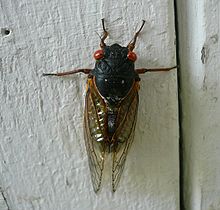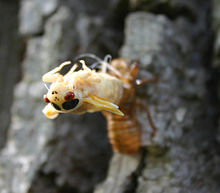


Brood XIII (also known as Brood 13 or Northern Illinois Brood) is one of 15 separate broods of periodical cicadas that appear regularly throughout the midwestern United States. Every 17 years, Brood XIII tunnels en masse to the surface of the ground, mates, lays eggs in tree twigs, and then dies off over several weeks.
Entomologist Charles Lester Marlatt published an account in 1907 in which he postulated the existence of 30 broods. The number has since been consolidated, and only 15 broods of periodical cicadas are currently recognized. Of these, twelve (Broods I through X, XIII, and XIV) are 17-year broods and three (Broods XIX, XXII, and XXIII) are 13-year broods.[1] Brood XI is extinct and Brood XII is not currently recognized as a brood of 17-year cicadas.[2]
The 4 cm (1.6 in) long black bugs do not sting or bite. Once they emerge, they spend their two-week lives climbing trees, shedding their exoskeletons and reproducing. Brood XIII can number up to 1.5 million per acre (3.7 million per hectare). The brood is reputed to be the largest emergence of cicadas known anywhere.[3]
The brood's most recent major emergence occurred during the spring and early summer of 2024, throughout an area roughly enclosed by northern Illinois, eastern Iowa, southern Wisconsin, and a narrow strip of Indiana bordering Lake Michigan and Michigan.[3] A premature emergence occurred in 2020.[4] The brood will emerge again in late May 2041.[2][3][5]
- ^ Susan L. Post. "A Trill of a Lifetime". Illinois Natural History Survey. Champaign, IL: University of Illinois. Archived from the original on 2012-05-11. Retrieved 2024-01-25.
- ^ a b David Marshall, John Cooley, Chris Simon (2024). "Magicicada broods and distributions". Ecology and Evolutionary Biology. Cicadas. Storrs, Connecticut: University of Connecticut. Retrieved 2024-01-25.
{{cite web}}: CS1 maint: multiple names: authors list (link) - ^ a b c Schuster, James; Nixon, Philip. "Timed to perfection: Cicada's biological clock determines emergence". Insects: Cicadas. Urbana, Illinois: University of Illinois Urbana-Champaign College of Agricultural, Consumer and Environmental Sciences: Illinois Extension. Archived from the original on March 10, 2024. Retrieved March 12, 2024.
The northern Illinois brood, which will emerge in late May 2024, has a reputation for the largest emergence of cicadas known anywhere. This is due to the size of the emergence and the research and subsequent reporting over the years by entomologists Monte Lloyd and Henry Dybas at the Field Museum in Chicago. During the 1956 emergence, they counted an average of 311 nymphal emergence holes per square yard of ground in a forested floodplain near Chicago. This translates to 1½ million cicadas per acre. In upland sites, they recorded 27 emergence holes per square yard, translating to about 133,000 per acre. This number is more typical of emergence numbers but is still a tremendous number of insects. .... 2020 | Northern Illinois Sub-Brood (part of Marlatt's XIII)
- ^ "Chicago Area Periodical Cicada Emergences in 2020". Cicada Mania. Retrieved 2024-04-10.
- ^ "Genus Magicidada: periodical cicadas". Singing Insects of North America. Gainesville, Florida: University of Florida. Archived from the original on December 10, 2008. Retrieved October 26, 2011.